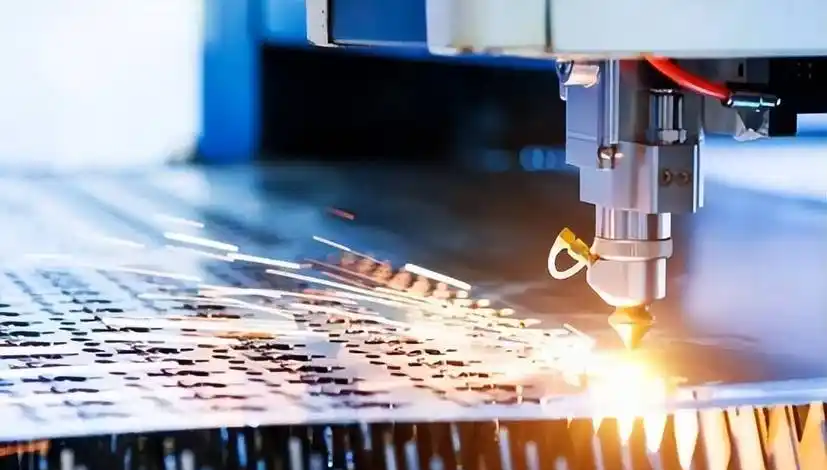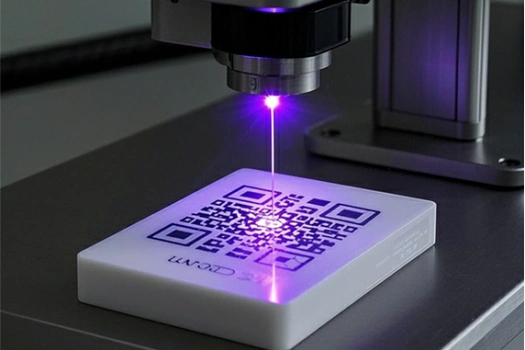Many customers struggle to understand the differences between various laser configurations when purchasing our equipment. Knowing which type of laser best suits your industry needs is critical to selecting the right system. In this article, ZS Laser provides an in-depth comparison between two of the most common configurations—CO2 lasers and UV lasers—to help you make the most accurate choice.
Introduction to CO2 Laser Technology
CO2 lasers have been around for decades. As a cornerstone of industrial manufacturing, they are powerful, reliable, and widely used for processing a broad range of materials.
Working principle
A CO2 laser is essentially a gas laser that generates a laser beam by electrically exciting a carbon dioxide gas mixture. What sets it apart is its wavelength. Operating in the far-infrared spectrum, CO2 lasers produce light at 10.6 μm (10,600 nm), which is readily absorbed by organic materials and water.
This absorption leads to thermal processing. When the beam hits the material, it rapidly heats the surface, causing it to melt, vaporize, or burn. This makes CO2 lasers highly efficient for cutting and engraving thicker non-metallic materials.

CO2 laser processing
Key Features and Applications
CO2 lasers deliver high power output and excellent efficiency across many applications. However, thermal processing creates a Heat-Affected Zone (HAZ). Excessive heat may leave behind charring, melting, or discoloration at the edges. While acceptable for many uses, this may not meet the requirements of applications where flawless edge quality is essential.
Ideal applications include:
Industrial cutting: plywood, MDF, leather, acrylic.
Marking and engraving: glass, ceramics, textiles.
Paper and packaging: high-speed cutting and perforating.
For customers prioritizing cost-effectiveness and high-speed processing of non-metallic materials, CO2 lasers are often the best solution.
A Closer Look at UV Laser Technology
UV lasers, often referred to as “cold processing” lasers, are the preferred choice for high-precision applications, particularly where strict control over thermal damage is required.
Working principle: Photochemical ablation
Unlike CO2 lasers, UV lasers operate at a much shorter wavelength, typically 355 nm. At this wavelength, photons carry higher energy. When they strike a material, they can directly break molecular bonds without generating significant heat. This process, called photochemical ablation, removes material in a controlled, non-thermal way.
Instead of burning material away, UV lasers act like a precise surgical tool, eliminating the Heat-Affected Zone and thermal stress altogether.
Key Features and Applications
The greatest advantage of UV lasers lies in their unmatched precision. Their cold processing ensures clean, burr-free edges with no charring or melting. This makes them ideal for industries where even minimal heat damage is unacceptable.

UV Laser Marking
Typical applications include:
Electronics: cutting flexible printed circuits (FPCs), PCB drilling, chip marking.
Medical devices: precise cutting of catheters and stents.
Micromachining: crack-free cutting of brittle materials such as glass, sapphire, and ceramics.
For customers working with heat-sensitive materials or requiring micron-level precision, UV lasers are indispensable.
Key Differences at a Glance
| Feature | CO2 Laser | UV Laser |
| Wavelength | Far-infrared (10.6 μm) | Ultraviolet (355 nm) |
| Processing Method | Thermal (melting, vaporizing) | Cold (photochemical ablation) |
| Heat-Affected Zone | Present | Minimal or none |
| Processing Precision | Lower than UV | Extremely high |
| Typical Materials | Wood, acrylic, leather, glass | FPC, glass, ceramics, plastics |
| Best Use Cases | High-speed, cost-efficient cutting | Micromachining, high-precision marking |
ZS Laser Helps You Choose the Right Solution
When deciding on a laser system, you can take a short think:
What materials do you need to process?
How high are your precision requirements?
Is flawless edge quality critical (no charring, no melting)?
What is your budget and production efficiency target?
If your application involves high-speed cutting of thick wood or acrylic at a competitive cost, a CO2 laser is the clear choice. If you work with delicate electronic components or brittle glass parts, a UV laser is far more suitable.
By understanding these core differences, you can make a smarter purchasing decision. As a trusted supplier, ZS Laser is always ready to consult with you. We provide tailored solutions that align with your production needs, helping you reduce costs and improve efficiency.
We look forward to your inquiry. Contact us today to get your customized laser equipment solution.
 ZS Laser Equipment
ZS Laser Equipment


WhatsApp
Scan the QR Code to start a WhatsApp chat with us.